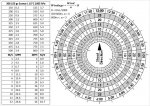D
Deleted member 113831
Guest
Not really intended as criticism.Its good to make things as simple as possible, but not simpler.
I get the impression Sawdust gets it and has things worked out in a way that HE understands and relates to.
Different people process information differently, but as long as they get there and in this case it works for him, who is anyone to criticize?
If you are getting hits, then you are doing it right enough for sure. My intention was more to add counterweight to the conversation.
Some have an innate tendency to get off into the weeds. This can sometimes overwhelm the beginner.
That is my only reason for bringing it up. I'm out.


